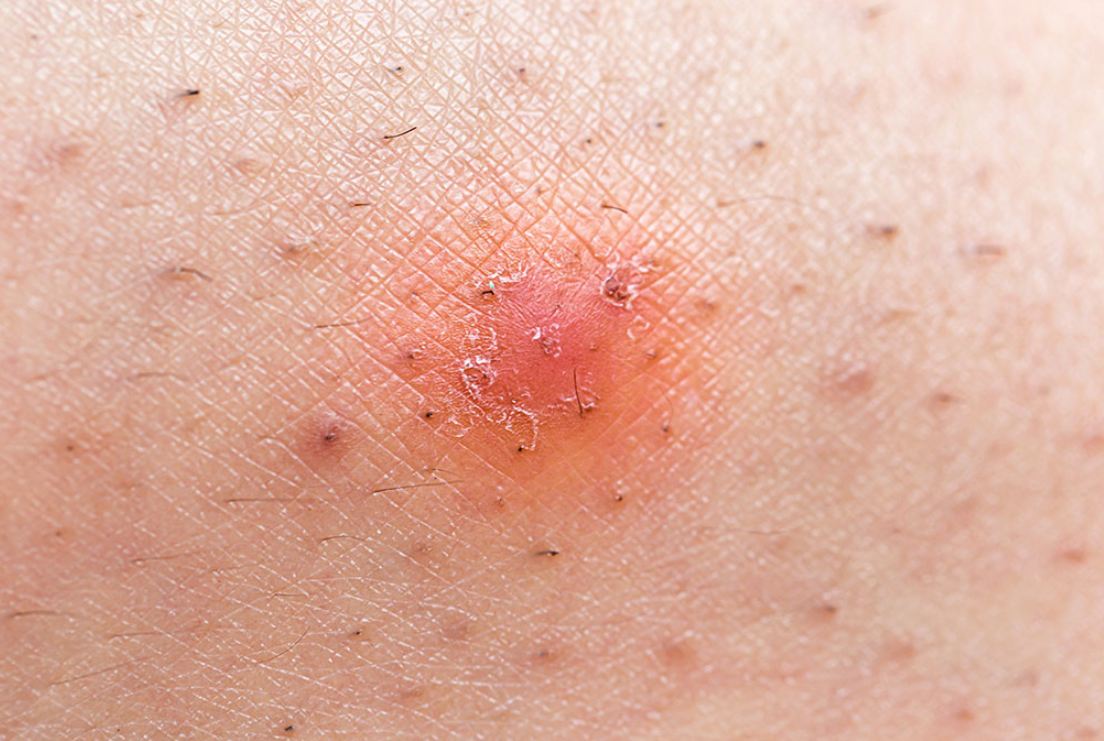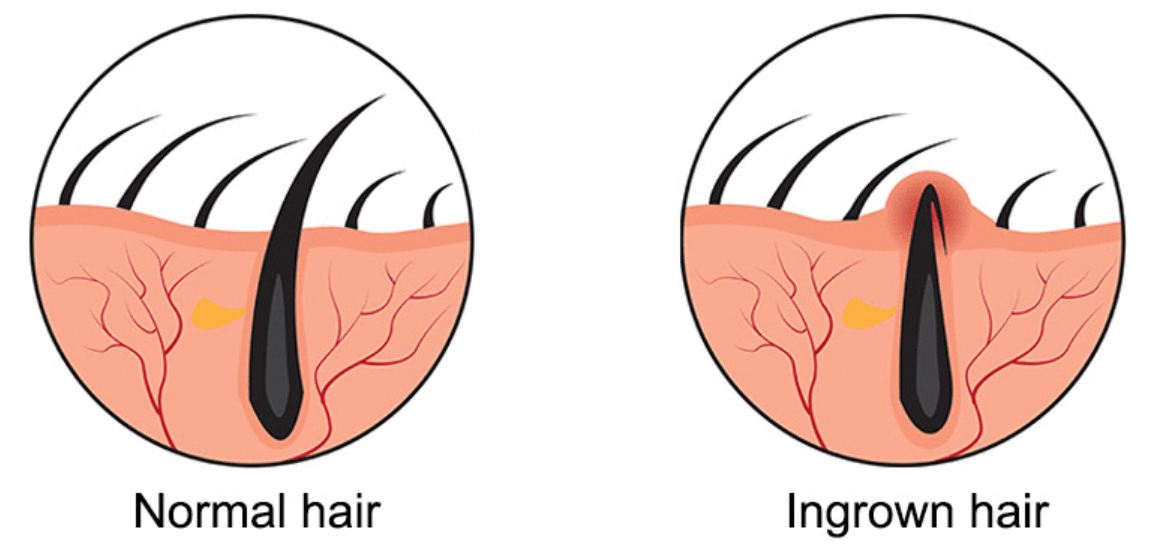As the name suggests, ingrown hair grows back into the skin instead of growing outwards. Various hair removal methods can contribute to developing ingrown hair, the most common culprit being shaving.
What does it look like?
Ingrown hair appears as dark, red raised bumps on the skin’s surface, looking very similar to pimples.
They are seen in areas where hair is removed. For example, common sites of ingrown hair in men include the face and neck, and in women, have the armpits, legs, and bikini area.
Why does it occur?
A typical hair follicle starts its journey from the root and continues to grow, emerging through the skin’s surface and outwards. However, suppose the normal hair growth cycle is interrupted for various reasons. In that case, the growing end is diverted to grow back into the skin’s surface, thereby plugging that hair follicle from which it arose. This leads to what we know as ingrown hair.
 Various factors that contribute to the formation of ingrown hair include:
Various factors that contribute to the formation of ingrown hair include:
The Hair Type: People with tight, curly hair have increased chances of ingrown hair as the hair naturally tends to curl and grow sideways or back into the skin.
The Hair Removal Method: The hair removal method one uses is also an essential contributor to the development of ingrown hair. Shaving cuts hair at an angle, which may cause the hair to grow inward. They are also making the skin taut, while shaving can contribute to the formation of ingrown hair since the hair retracts under the skin.
Other hair removal methods, such as waxing and epilation, remove the hair from its root. However, when the hair grows back, there is a chance for the hair to grow in a different direction rather than straight out of the skin’s surface.
Tight-fitted clothing: The constant rubbing of tight-fitting clothing with the skin’s surface can misalign the growth of the developing hair in the wrong direction, thereby increasing the chances of ingrown hair development.
How to prevent Ingrown Hair?
The best way to prevent ingrown hair is not to remove hair. But this is not the remedy most look forward to.
Try Alternative Hair Removal Techniques: Another best practice is to trim hair rather than shave it. Trimming the hair leaves some amount of hair above the skin’s surface, reducing the possibility of ingrown hair. This is an acceptable practice for men if they suffer from ingrown hair repeatedly over the face, but it is not possible for women who wish to have hair-free arms and legs.
Opt for Laser Hair Removal- Another good way to prevent ingrown hair is to opt for laser hair removal as the hair removal method. Whether you go for in-office procedures or at-home laser hair removal using reputable devices such as Ulike’s Air 10, laser hair removal destroys the hair root and reduces hair growth over time, thereby eliminating the problem of misaligned hair growth.

Ingrown hair removal treatment
In case you already have ingrown hair, using the following may be helpful:
- Over-the-counter alpha hydroxy acids, such as glycolic acid, between hair removal sessions, can help exfoliate and decrease the formation of ingrown hair.
-
A mild retinol can increase the cell turnover.
-
A mild topical steroid can reduce if the ingrown hair is associated with inflammation. (use sparingly)
However, it is essential to consult your dermatologist for advice and treatment guidance that works best for you.
Ingrown hair is a widespread occurrence and nothing to worry about. Equipping yourself with the proper knowledge and taking steps towards your skin goals will help you achieve flawless and healthy skin.
References
-
Luo, D. Q., Liang, Y. H., Li, X. Q., Zhao, Y. K., Wang, F., & Sarkar, R. (2016). Ingrowing Hair: A Case Report. Medicine, 95(19), e3660. https://doi.org/10.1097/MD.0000000000003660
-
Crutchfield C. E., 3rd (1998). The causes and treatment of pseudofolliculitis barbae. Cutis, 61(6), 351–356.
-
Ogunbiyi A. (2019). Pseudofolliculitis barbae; current treatment options. Clinical, cosmetic and investigational dermatology, 12, 241–247. https://doi.org/10.2147/CCID.S149250
Bio: Dr. Sanober Pezad Doctor, MD
A Gold Medalist from medical school, Sanober holds multiple national and international awards, scholarships, research studies, and recognition for novel therapies to her credit. She is a proactive, compassionate medical practitioner who thoroughly understands overall mind-body-spiritual wellness. She is also a simple mommy to the core and strongly believes that prevention is better than cure. Her ultimate goal is to help everyone be the healthiest version of themselves. Join the tribe and get a copy of her coveted ‘Glow from Within’ Guide to help you nourish and glow from the inside out.

 By myulikeadmin
By myulikeadmin



